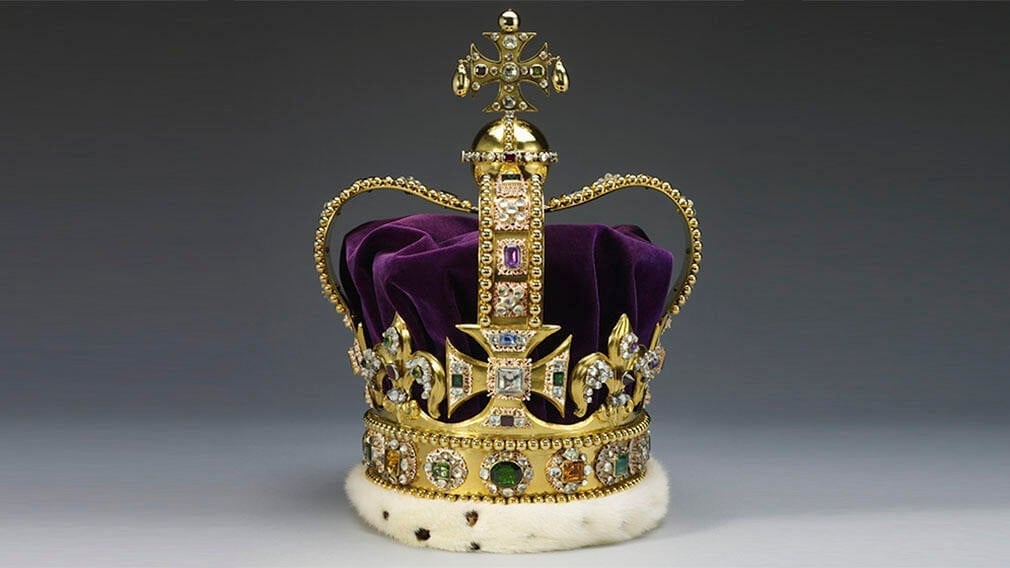Everything You Need to Know About St. Edward’s Crown Ahead of King Charles III’s Coronation
3 Minute Read
The St. Edward's Crown, which has played a major role in the coronation of monarchs in England for more than 350 years, has been transported to an undisclosed location for modifications ahead of King Charles III's coronation this spring.
One of the most famous objects of the entire Coronation Regalia, St. Edward's Crown has a rich history and a hefty valuation of some $57 million. Now, with King Charles III's coronation coming up on May 6, 2023, the world will get to admire it again in public after being last used 70 years ago for the coronation of Queen Elizabeth II.
History of St. Edward's Crown
This actually isn't the first time this crown has had some work done. In fact, the St. Edward's Crown used today replaced a medieval version that dated back to the 11th century. The original crown, which is thought to have been worn by Edward the Confessor, didn't survive the abolition of the monarchy in 1649, having been melted down and sold off during the purge. However, drawings and historical documents allowed the Royal Goldsmith, Robert Vyner to recreate the crown in 1661 when the monarchy was re-established. Although, they purposefully didn't create an exact replica of the historic crown, but instead created a similar crown that emanated the same regal feeling.
A little-known fact about this crown's (tumultuous) history is that it had to be repaired again just ten years after it was recreated. In 1671, parliamentarian Thomas Blood attempted to steal St. Edward's Crown, flattening it as he stuffed it in his cloak to steal it. Miraculously, he was pardoned and the crown was mended. Although, one more permanent alteration would be made a few centuries later.
How is the crown used?
This magnificent solid gold crown is used solely at the moment of crowning during the coronation ceremony. A sacred and religious piece, St. Edward's Crown is like much of the Coronation Regalia and is only set aside for this momentous occasion. In fact, the last time the crown was worn was 70 years ago by Queen Elizabeth II.
After wearing St. Edward's Crown to be coronated King Charles III will put on the Imperial State Crown — which was created in 1937 for the coronation of King George VI — to leave Westminster Abbey. Unlike St. Edward's Crown and the other Coronation Regalia, the Imperial State Crown is worn for other royal duties and engagements, too.
Design and gemstones of St. Edward's Crown
With bright, glittering gems, tall golden points, a purple velvet cap and a white spotted ermine band, St. Edward's Crown is iconic, becoming a symbol of the monarchy across the world.
Commissioned by the Royal Goldsmith Robert Vyner, he was tasked with creating a new design that paid homage to the original that was melted down and sold off when the monarchy was abolished. According to the Royal Collection Trust, what Vyner did was follow the original design by recreating a solid gold frame made of four crosses-pattée, four fleurs-de-lis, and two arches.
Over the years, stones were rented to fill the crown, which helped keep the upfront costs down, as the crown would only be fitted with the jewels during coronations. But in 1911, King George V had stones set in St. Edward's Crown permanently, outfitting it with 400 rubies, amethysts, sapphires, garnet, topazes and tourmalines, bringing its total weight up to 2.3kg (nearly 5lb).
This final major alteration to the crown is what we will see on display at King Charles III's coronation, the band now featuring rows of gold beads alongside sixteen different clusters of rectangular and octagonal step-cut stones set in collets and decorated in enamel with acanthus leaves.
Up above the band sits four crosses-pattée and four fleurs-de-lis taken from the historical and original design, each displaying larger step-cut stones alongside smaller rose-cut stones. The gold beads from the band also flow up the two arches, the middle outfitted with enameled mounts with even more step-cut and rose-cut stones. Finally, the monde, which supports a cross-pattée, features gold beads in a drop shape, as well as similar mounts with step-cut and rose-cut stones.
Cate Misczuk
Cate Misczuk is a jewelry and watch writer who covers everything from the latest jewelry trends and the heritage of watchmaking to 24k gold, gems, sustainability, unisex timepieces and more. Get in touch at catemisczuk.com.
Related Articles
Exclusive: IGS Reveals the Most Popular Gemstone by State for 2023
The Controversial Diamonds Queen Camilla May Wear to King Charles’ Coronation
Emerald Jewelry Leads Spring 2022 Trends As Celebrity Engagements Leave Consumers Green with Envy
EU and UK Sanctions on Russia Continue to Exclude Diamonds
Latest Articles
Opal Buying Guide
Amethyst Sources Around the World: The Geological Story Behind These Purple Gemstones
Brazilianite Value, Price, and Jewelry Information
Ruby-Glass Composites vs Leaded Glass Clarity Enhancements
Never Stop Learning
When you join the IGS community, you get trusted diamond & gemstone information when you need it.
Get Gemology Insights
Get started with the International Gem Society’s free guide to gemstone identification. Join our weekly newsletter & get a free copy of the Gem ID Checklist!
